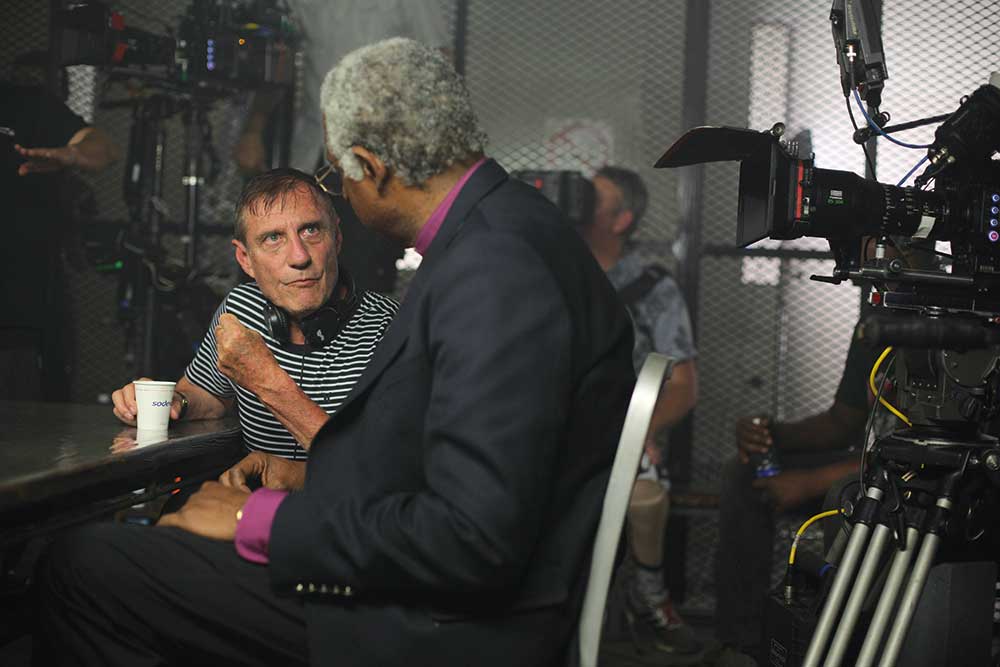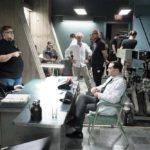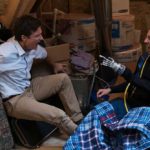
The Forgiven
Posted on May 9, 2018 by Julian Mitchell
We speak to DOP William Wages and Director Roland Joffé about the look for this moment in time new movie
William Wages, ASC, is a hugely experienced cinematographer with credits behind the camera stretching all the way back to 1979. As such, he is a rare example of the Hollywood moviemaker who has never lived in Los Angeles. “I never moved out there to Hollywood,” he chuckles. “I don’t keep it a secret – nobody asked, so I don’t tell them!”
William began shooting at the tender age of 16. He worked, he says, “a summer job at a machine shop and bought the Bolex and a 25mm lens… the only thing I didn’t have was film, that was the expensive part. A show came into Atlanta which was basically like MTV. They made videos of people dancing, typical stuff of the 70s. They said, ‘here’s three rolls of film. If we like it, we’ll give you two hundred and fifty dollars’. I was at high school. My grades plummeted, but my filmmaking…”. History finishes the sentence.
Paying the Wages
 The Forgiven is shot on location in Cape Town’s Pollsmoor Prison.
The Forgiven is shot on location in Cape Town’s Pollsmoor Prison.
Having worked on almost every type of production, William’s recent credits include several television series, including episodes of Burn Notice, Revolution, Containment and most recently Sun Records, on which he met director Roland Joffé. William remembers the latter production as being “about the beginning of rock and roll in Sun Studio. Sam Phillips, who discovered Elvis, Johnny Cash, Jerry Lee Lewis, was the centre of the rock and roll universe in this converted garage in Memphis.” This production would turn out to be prophetic, based on William’s use of Panasonic’s Varicam series alongside their compact Lumix stills cameras, for use in tight spaces. William describes Roland, who immediately liked the combination of Varicam and Lumix, as being “as progressive a thinker as anyone I’ve ever been around.”
On Sun Records, Roland and William found themselves in such a state of creative agreement that much of the usual discussion could be short-circuited. “If we did a shot list, it was the same. I still did the prep but we didn’t compare notes any more because we were on the same page… and halfway through he told me about The Forgiven in South Africa.” William had worked in the country before, and “I know the ropes, so I jumped at the chance.” Even so, the production was immediately challenging. “The budget was still in flux. When we got there we had to decide what we could do. My philosophy of making movies, and Roland’s, is that you don’t look at what you don’t have, you look at what you have. You have a script, you have the actors and all this other stuff to make the movie. Don’t focus on what you don’t have.”
Travelling light
 On set in South Africa.
On set in South Africa.
The Forgiven is based on Michael Ashton’s stage play The Archbishop and the Antichrist, which describes a fictional – or at least fictionalised – series of events in which Desmond Tutu, the titular archbishop, meets a death row inmate in a grim South African prison. Shot during 2016 on location in Cape Town’s Pollsmoor prison, the production boasts a cast including Eric Bana and Forest Whitaker as Desmond Tutu. Pollsmoor is still a working prison, and only the intervention of the real Desmond Tutu made it practical to shoot there. Even then, the production was forced to move quickly and travel light in order to make such a sensitive location practical.
To this end, William combined the Varicam 35 with Fujinon’s cinema zoom lenses, particularly the Cabrio ZK4.7×19 19-90mm T2.9 and the Cabrio ZK3.5×85 85-300mm T2.9-4.0. “This lens and this camera combination are what allowed us to make the movie the way we did,” William continues. “In Paris I saw the movie for the first time in a really wonderful rental facility in a beautiful screening room. As fate would have it, I had to sit in the front row which is the worst seat in the house, where I could really see the flaws. But even sitting 15 feet from the gigantic screen it looked tremendous.”
Getting down to specifics, William tells us that, “With this camera, if we go indoors or outdoors, day or night, it doesn’t matter. I’m at ISO 5000. There’s a filter wheel in the camera so I can turn the 5000 into 400 if I need to, so I’m not at f/11.” William made frequent use of this straightforward option to balance ND filtering against aperture in order to control depth-of-field. “If the A camera is at 25mm, the B camera may be at 150mm. If I shoot both at f/2.8 then it’s a completely different look. With this camera, I can spin the filter wheel and give B camera an f/5.6 – so both the subjects’ eyes are in focus. I hate it when we’re saying ‘which eye do we want in focus?’. This camera allows that.”
 The Panasonic Varicam and Fujinon 85-300mm zoom on set.
The Panasonic Varicam and Fujinon 85-300mm zoom on set.
William pursued a realistic image, keen to avoid betraying the reality of the location with overly manufactured photography. “What I said to Roland was that I feel my job is for nobody to know I was ever there,” he says. “I want it to be real. Brutally real, and not affected with perfect Hollywood-style lighting and all of that. That sounds like I didn’t do anything – in fact I worked harder. That Hollywood style three-point lighting is pretty easy to do, but to go into a place like this and make it feel natural when nothing was real, that’s a whole different story. I don’t want them to think about the camera. I want them to think about the mood and the atmosphere.”
Under the circumstances, William found himself spending a lot of time controlling the available light. “I light with the grips,” he says. “I spend time blocking windows, taking bulbs out of fixtures to create the mood. Obviously, we’re using light fixtures too, but it’s a whole different philosophical approach than what I’ve been doing for thirty years. It’s subtractive.” With regard to equipment. William mentions “a survival kit of battery operated LED lights that I bought on Amazon from China. I would buy them one at a time to find one that worked, that met colour standards. Then I bought a bunch of them. Instead of going to the movie industry and getting the light that costs $2000, I have the light that costs $50, and it came with two batteries. I can’t do a whole movie with it, but in that prison we did the vast majority of it with that stuff. The guys down there loved it so much that, as far as my carnet was concerned, I lost them.”
The go-to Fujinon lenses

William is confident that Cabrio 19-90mm zoom lens covers “90% of what you’ll ever do with A camera. The 85-300 on the B camera is the same thing. So, when you’re in dusty, dirty environments you’re not changing lenses. But the most important thing is when you change lenses it’s a three-minute operation – but make-up and hair hears it, maybe I will go in and tweak something, so that three-minute procedure becomes seven minutes, ten minutes. If we’re on the 19-90mm or the 85-300mm, we reach down, zoom it a little bit, you’re good to go and we didn’t even cut.”
Things moved so quickly that even the cast started to notice. “Eric Bana looked at the camera and read the brand name on it, thinking that was what the magic was,” William continues. “We talked about it and I said yes, that’s part of the magic, but what he’s talking about was that when they’re in the moment, in these intense scenes, they didn’t lose the moment. We could keep going.”
Speed, William says, is one reason to use zooms. “The other is that having a huge box of [prime] lenses, which costs a lot to rent, is necessary with some cameras. You need the speed. With this camera you don’t need the speed… it cleans up the cart, we don’t have all this junk to move around.” A final benefit, he says, is sheer flexibility. “With this lens I have a 22.5mm or a 46mm. I have never done a zoom shot with these lenses, never. It’s a variable prime.”
As to quality concerns over zoom lenses, which are inevitably more complex than primes and involve more pieces of glass, William’s response is simple. “I started using them because I blind test lenses. All modern lenses are pretty much the same. Yes, there are subtle differences, but the technology is so advanced that in an actual scene in a movie you can’t tell the difference from one lens to the next. I stress, there are subtle differences – but do they matter?”
He’s cautious, too, about the approach to lens tests that is often taken. “What a lot of people do is shoot a test and look at it on the camera, and they haven’t gone through colour correction. That’s like holding up a piece of orange negative and trying to figure it out. Every test I do, I go through colour timing. You can’t tell from a negative. You have to print it. You go through colour timing with all these lenses, the Zeiss are slightly harsh and blue, or the Cookes are slightly warmer and not quite as harsh. All that can be negated in colour timing to make them all look the same.”
Mild diffusion
 Forest Whitaker as Desmond Tutu with director Roland Joffé.
Forest Whitaker as Desmond Tutu with director Roland Joffé.
The Fujinon zooms were so sharp, in fact, that William elected to use mild diffusion. “I do dumb the lenses down a bit,” he says. “I don’t use diffusion that much with film, but with digital I do. Lenses are getting sharper and sharper and actors are hating it more and more. I used Glimmerglass a lot – I invented that filter, and I used to make them myself with optical glass and optical cement! Then I showed them to Ira Tiffen.” William describes the effect of the Glimmerglass as similar to that of a net, but without imposing a patterned appearance on out-of-focus areas of the scene.
“How they made a 19-90mm that size is miraculous,” William marvels. “The 85-300mm is even more so because it’s a 2.9 [almost] all the way out – it clams down at 220mm, but it doesn’t clamp down enough that it matters.” Through this approach, William’s crew were able to eliminate two complete carts of equipment, something that streamlined the production enormously. “Any time you can eliminate something without compromising you can save time. The combination of using those lenses and this camera – Roland and I talked about it – and we figured we saved an hour to an hour-and-a-half each day by not changing lenses. We still worked 12 hours a day, so what we got was another take, another set-up, another three set-ups, maybe. It became more about making the movie rather than technology, it allowed me to whittle away some of the wall of tech that’s between my process and the actors’ process.”
“This is the way things are going,” William concludes. “The flip side of that is that the process of making a movie is exactly the same. That hasn’t changed since the silent days. To do it well is just as hard as it ever was. But getting onto the field has changed.” The combination of Fujinon’s zoom lenses, the highly-sensitive Varicam and William’s dedication to a streamlined camera department allowed the production to be completed in 24 days. “It was fast,” William says. “Without these things it wouldn’t be the movie that it is.”














